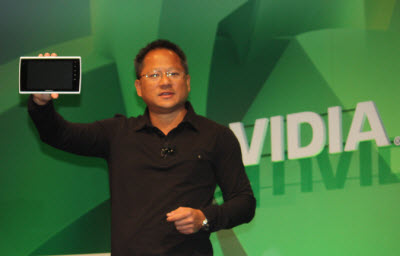 Nvidia chief executive Jen-Hsun Huang declared that 2010 will be the year of the tablet computer.
Nvidia chief executive Jen-Hsun Huang declared that 2010 will be the year of the tablet computer.
Of course, that has a lot to do with the fact that the graphics chip maker has a new chip for use in tablet computers, the just announced Tegra 2. Huang spoke at the Santa Clara, Calif.-based chip maker’s press conference at the Consumer Electronics Show in Las Vegas today. About 50 new Tegra-based tablets are in the works, including one that Huang held up.
“This year is going to be absolutely wild,” Huang said.
Apple has a rumored tablet product coming on Jan. 27, of course. Nvidia is not likely to get its chips into that one, since Apple bought PA Semi to make chips for that purpose.
But Huang argued that Nvidia has done the basic plumbing with Tegra to enable the tablet devices to take off. Huang showed off a half-dozen different tablets on stage, doing a live demo of one being used for e-commerce. He said that Adobe will port its Adobe Air software to the Tegra platform so that Tegra-based machines will be able to display rich content such as digital magazines. Huang said big Taiwanese computer manufacturers such as Compal, Quanta, MSI, and Asus are involved.
Tim Sweeney, chief executive of Epic Games, joined Huang on stage to talk about his excitement over the great processing power and 3-D graphics now coming to the mobile gadget and cell phone industries. Chips like Tegra 2 add the graphics horsepower to make toys into something more gorgeous, Sweeney said. Sweeney said his company and Nvidia have ported the Unreal Engine to the Tegra platform. They showed the full version of Unreal 3, a first-person shooter game that runs on game PCs, running on the Tegra. The game was working live on a prototype tablet.
Comparing Tegra to the Nintendo DS grahpics, Sweeney said, “They’re decades apart. We’re only a decade away from reaching true movie-like graphics in games. It’s only a matter of time before that comes to the mobile industry.”
Tegra is also being used in navigation systems being designed for cars. Mathias Halliger, a chief architect of the info systems at Audi, said that computer technology can revolutionize driving in terms of better safety, information and entertainment in cars. Huang and Halliger showed Google Maps-based navigation working in a car mock-up.
Huang also talked about how the movement to create 3-D viewing of computer games has developed in the past year. A year ago, Nvidia introduced its 3D Vision glasses for viewing games and movies on a PC or on specially-equipped rear-projection TVs. The kit combines glasses, an input system, monitors, and a graphics card. With it, just about game can be viewed in 3-D.
This year, Huang said the technology is gaining momentum. Today, Asus, MSI and Klevo are all introducing laptops with screens that are ready for Nvidia’s 3D Vision product. Acer, Alienware, and LG will also make their gaming monitors for desktops ready for 3D Vision. Nvidia will also pack the new Avatar game with its Nvision kits.
Lastly, Huang said Nvidia’s new graphics chip, code-named GF100, or Fermi, is in mass production and will be available soon. The new chip can handle 6 million pixels on screen, at 120 hertz. That means it can run great 3-D viewable content. The chip is on display at the Nvidia booth for demos, but Huang did not show any.
Check out our CES 2010 coverage.

